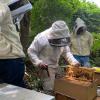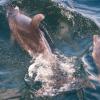Marine reserve design criteria and measures of success: lessons learned from the Exuma Cays Land and Sea Park, Bahamas
Among the many potential benefits of no-take marine reserves, three important postulated effects are (1) to supply biomass of harvestable individuals to fished areas through emigration; (2) to increase spawning-stock biomass, which subsequently magnifies larval recruitment; and (3) to restore more natural size-frequency distributions of the protected populations, specifically to enhance the larger size classes, which may affect sex ratios and reproductive output. The Exuma Cays Land and Sea Park (ECLSP), covering 442 km 2 in the central Bahamas, was established in 1958 and closed to fishing in 1986, making it one of the first and largest marine reserves or 'no-take' zones in the western Atlantic. The ECLSP is ideally situated between small-scale developments in the northern and southern Exuma Cays and encompasses a diversity of contiguous shallow-water habitats from the Great Bahama Bank to the eastern platform margin in Exuma Sound. Scientific investigations during the past decade have compared queen conch, spiny lobster, and grouper resources in the ECLSP to those in adjacent fished areas and have demonstrated greater species diversity, density, biomass, potential reproductive output, and larval densities for these species. The lack of historical data limits determination of whether closure to fishing has resulted in increases in these attributes over time, but available data strongly support the contention that the ECLSP has significantly greater spawning-stock biomass of various organisms because of protection from fishing. Although evidence is strong that the ECLSP is an important source of larvae to adjacent areas in the Exuma Sound ecosystem, few data show adult emigration to fished areas. Some target species outside the reserve may have declined, and because the ECLSP probably depends on larval transport from upcurrent areas, awareness is growing that this reserve will not be successful in isolation. Experiences in the ECLSP suggest that marine reserves will be most successful if they contain contiguous habitats from bank to deeper shelf (>30 m) environments, minimize threats such as coastal development, and provide protection of unique features such as spawning aggregations.
Area of Interest: Bahamas
Year: 2000




